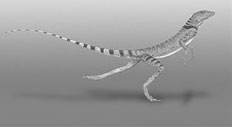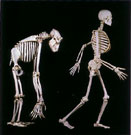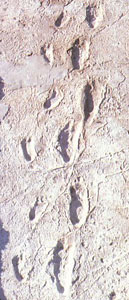| Human – ancestral – initial - primeval bipedalism |
Bipedalism
The first traces of hominid's footprints at Laetoli.

Bipedalism... a story which goes back to 3.6 million years ( at least ) !
It was at Laetoli in Tanzania that Mary Leakey discovered the most ancient evidence of bipedalism. Preserved in volcanic ash, the footprints of an adult hominid are coupled with those of a child following in his footsteps !
Some 3.5 million years ago, both were heading north, walking across the ash of a nearby volcano. Their traces vanish further, covered in the scoria of other eruptions.
March 2003 – The recent footprints found at Roccamonfina (Italy) date only back to 350 000 years (paleolithic)... If they are the first evidences of bipedalism in Europe, they are not the most ancient ones (and by far!) . According to the Museum de Science Naturelle of Trento, they can be attributed to our European ancestors homo erectus or heidelbergensis.
But the origins of bipedalism are more ancient...
A little bit of history...
At the beginning of last century, it was all settled... What differentiates a man from an animal is that the former walks on his two legs... This allowed a simple, speedy and even comforting differentiation: I can walk, therefore I am a man, and therefore I am not an animal ! |
The first known biped was a reptile !
Eudibamus cursoris lived 290 million years ago.
 Eudibamus cursoris
Eudibamus cursoris |
Discovered in 1993 at Gotha, in Germany, this herbivore dating from the end of the Permian era must have been 26.1 cm ( 10 inches approx. ) long and able to reach a speed of 24 km/h ( 15 miles/ hour ) ( according to David Berman, Carnegie Musum of Natural History ).
It is supposed to have used this ability to escape its predators.
Eudibamus cursoris proves that bipedalism appeared in various classes several times during evolution. |
| |
 A first theory abandoned... bipedalism would have been brought about by the environment.
A first theory abandoned... bipedalism would have been brought about by the environment.
The first scientists who studied human bipedalism initially thought that necessity has force of law. A change in the environment would have been at the origin of this evolution. The Austalopithecine would have passed from forest to savannah. They would have straightened up in order to have a wider visual angle and anticipate potential attacks or find preys more easily. By straightening up they could also intimidate their potential opponents. As bipedalism freed their hands, our ancestors could carry tools or weapons more easily. This theory, according to which an individual evolves (and becomes a biped) under the pressure of environment, is no longer developed. Moreover, the examples of animals using tools, without being bipedal for all that, are numerous...
(image : comparaison gorille
/ Homo sapiens)
|
| |
 A second theory : bipedalism is nothing new !
A second theory : bipedalism is nothing new !
A mere observation of present fauna shows us that man is not the only one to use bipedalism as a means of locomotion. The big apes like chimpanzees, bonobos or gorillas regularly walk on two legs (in their own style!)
Therefore bipedalism is not an evolution but a comon characteristic to all Hominidae. This ability is not used as frequently by all but is common to all.
The first traces of bipedalism can be dated back to Orrorin Tugenensis (6 million years) whose skeleton is explicit about his ability to walk : a very long femur crowned with a thick head. Together with the Australopithecus anamensis it constitutes the first line of real bipeds heralding the arrival of Homo ergaster and eventually modern man.
Australopithecine (afarensis and africanus) are grouped together in another line. If they retain the ability to climb and hang, they also possess morphological features proper to bipedalism. This reveals a mixed and varied mode of locomotion... given the circumstances !
Bipedalism has exised for more than 6 million years. It was used by our ancestors as well as by contemporary big apes. Among the hominids, this ability has developed as time passed by to become modern men's only means of locomotion. Consequently, it is not a distinguishing feature.
(image : Laetoli,
Tanzanie, by Mary Leakey) |
| |
A new theory : original bipedalism.
Against the current of common thinking (and political correctness!), several scientists no longer consider bipedalism as a recent acquisition of hominids. They put forward the theory that, on the contrary, we have an ancestor for whom bipedalism was the main mode of locomotion. Two ideas naturally ensue from this :
-
contemporary big apes use bipedalism less than our/their common ancestor and have become arboreal,
-
the human line has not adopted this mode of locomotion since our ancestors already mastered it...
 Yvette Deloison is a researcher at the CNRS (Centre National de la Recherche Scientifique) and a specialist in the analysis of the mechanics of hominid's lower limbs. Relying on the studies on the anatomy of our ancestors but also of the big apes, she comes to the following conclusions :
Yvette Deloison is a researcher at the CNRS (Centre National de la Recherche Scientifique) and a specialist in the analysis of the mechanics of hominid's lower limbs. Relying on the studies on the anatomy of our ancestors but also of the big apes, she comes to the following conclusions :
- the human hand can never have been an ape's hand (as being much more primitive),
- the human foot is highly specialized for bipedal walk.
Taking Bollo's Law (irreversibility of the evolution) into account, these elements lead Yvette Deloison to propose an ancestor with a straightened up bipedal attitude : the protohominoid.
Short in stature and living in a semi-watery environment, it would have lived 15 million years ago (without fossil remains having been found yet however).
Yvette Deloison first published this theory in 1999 in the review : Biométrie humaine et Anthropologie, 1999, 17, pp.147-150.
Suggested reading: Yvette Deloison's paper : « L'homme ne descend pas d'un primate arboricole » (Man does not descend from an arboreal primate).
|
If you want to go even further, read La Préhistoire du Piéton prehistory
The pedestrian's by Yvette Deloison, Plon.


|
Pascal Picq, a paleoanthropologist at the Collège de France, also questions the principle of the acquisition of bipedalism. On 10 August 2003, during a radio program dedicated to the bonobos (on France-Inter), he declared : "Bipedalism, bipedalisms are certainly more ancient than people think... I had made the assumption... bipedalism is ancestral ".
 Translation of "Bipédie" by Claude Ayme Translation of "Bipédie" by Claude Ayme
More suggested reading on bipedalism :
 A report : signs of bipedalism observed on a fossil.
A report : signs of bipedalism observed on a fossil.
One might rightfully think that the signs of bipedal walk are to be found only in the lower limbs of the skeleton. This is not so. Actually, it is the whole architecture of our skeleton which is impacted by our upright position and bipedalism. It may be considered as good luck, for these multiple indices are complementary, and it is extremely difficult to find a complete fossilized skeleton. The evidences of bipedalism from a fossil skeleton are therefore numerous, and, according to the unearthed remains, the probability of bipedal walk can be estimated.
|
News bipedalism (in french)
|
|
|
| |
| |
Translation 18/10/07 |
|